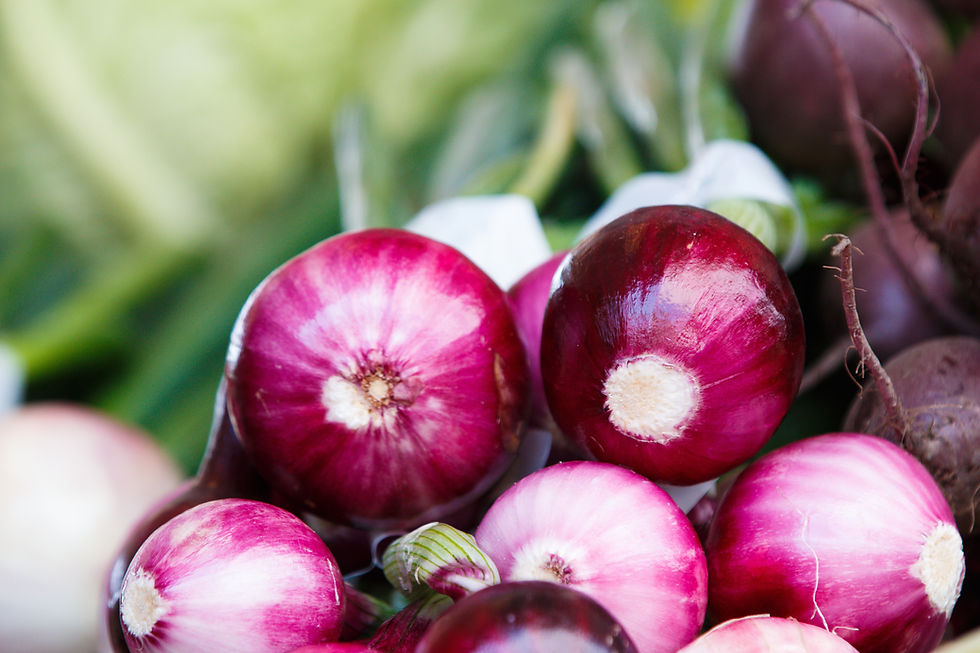February Is Onion Growing Time
- Donna Stephens
- Jan 9, 2024
- 3 min read
By: Lori Thomas
During these dark cold days of January, vegetable gardening seems months away. That is true for summer vegetables like squash and corn and peppers that need the warming soil and brighter sunlight of May to emerge and thrive. However, January is the time to start planning for cool-season vegetables.
My Favorite Cool-Season Crop? Onions!
Actually, onions are the only cool-season crop I grow with abundant success, though it wasn’t that way in the beginning. My first couple of attempts resulted in beautiful green onion tops, but no onion bulbs. “How can that be?” I thought to myself. Onions are the state vegetable of Georgia. Vidalia Onions are shipped all over the country (and world). Surely, I can grow onions in north Georgia. I researched onions and discovered the tricks to getting a good crop, and now I am like an evangelical prophet, preaching the good news of onions far and wide so that gardeners all across north Georgia can enjoy their own home-grown onions.

You might ask, “Why should I grow onions?
They are cheap and plentiful in the grocery store.” The answer to that question is the same as the answer to the question, “Why should I grow tomatoes.” Freshly harvested onions taste better than store-bought onions. At least that is my opinion. Then there is the pride of growing your own food, and sharing it with family and friends. If you grow a row of onions, you will have plenty to share.

Because onions are a cold-season crop, you can extend your growing season and the productivity of your garden by growing onions. In Hall County, you put onion transplants in the ground in mid-to-late February, and harvest in late May through June. Onions can be planted into the same rows as later-planted summer crops. Last year I harvested my onions on June 27, added compost to the row, and planted my okra seeds into the same row on the same day. By August, I was picking okra pods, and by October, I begged my husband to pull up the okra because I already had a freezer full of gumbo made from the onions and okra that were harvested from the same row. You can plant onions between the spaces where you will put peppers or tomatoes. The onions will grow and be harvested before the tomato plants start growing wild. School children can plant onions in February and harvest an onion bulb to take home before the end of the school year.
So what is the key to a good onion harvest?
Answer: plant the right type of onions at the right time.

Onions are photoperiodic, meaning that their growth is dependent upon the length of daylight hours. In Hall County, you can grow short-day onions or intermediate-day onions. Onions can be grown from seed, sets, or transplants. If you want to grow onions from seed, you plant the seed in fall (September or October) and hope for favorable winter weather (not too hot or dry, not too cold or wet). Onion sets, on the other hand, are small hard onion bulblets that you may have seen in the big box stores. The problem with growing onions from bulblets is that you have to live north of the Mason-Dixon Line. Only long-day onions form sets, and our summer hours of daylight do not meet the minimum 14-16 hours each day required for long-day onions to form bulbs.
The easiest way to get a good onion crop is to plant onion transplants. An onion transplant is a seedling about the size of a pencil which looks similar to a green onion. The onion transplants are grown commercially in south Texas, then shipped in late winter to onion growers.
Here Are Some Pointers For How To Grow Onion Transplants
Detailed information about soil preparation, fertilizing, watering, and harvesting can be found at DixondaleFarms.com.
Select a site with full sun and good drainage
Soil should be loose; if growing in containers, at least 10” of soil
Plant outdoors mid to late February
Plant the transplant 1 inch deep into the soft soil, firming soil around the transplant so that it stands up. During the following days, check that transplants are still upright.
Plant 4 inches apart.
Do NOT plant too deep, or the onion will not bulb up!!!
Water, fertilize, and weed during growing season
In May/June, plant will bulb up. Can be eaten anytime.
Harvest in June when leaves start to brown and fall over
To store, allow leaves to shrink around neck after harvesting, and paper skin form around bulb, then cut off the dried leaves at the neck just above the bulb
Store in cool dark place; refrigeration will extend storage time


Comments